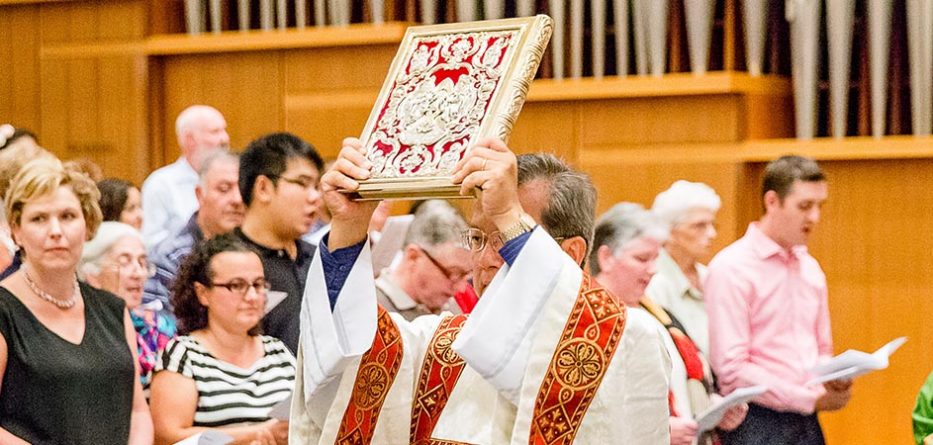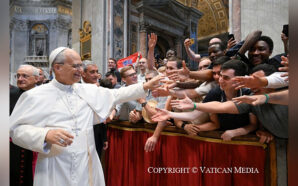If you wander into a Catholic Mass in Parramatta, New York, Rome, London, a tiny country church in outback Australia or a European village on any given day, you will generally hear the same Bible verses being read.
But who picked those readings? And why are they presented to us in this way?
Dr Paul Taylor, the Executive Secretary of the Australian Catholic Bishops Conference Bishops Commission for Liturgy, says the answer lies in the desire of the Second Vatican Council (1962-65) to draw more deeply on Scripture in the liturgical life of the Church.
“In general, following the Vatican II call for a ‘ressourcement’ or taking people back to the scriptural sources of our faith, the framers of the Lectionary wished to impart to the faithful a richer fare of readings from the various books of the Bible,” he said.
“There is therefore, greater selection of readings than with the selection for the Mass prior to 1969.”
The Vatican II Constitution on the Liturgy ordered that “in sacred celebrations there is to be more reading from holy Scripture and it is to be more varied and apposite”. (n.35.1)
“The treasures of the Bible are to be opened up more lavishly, so that a richer share in God’s word may be provided for the faithful”. (n.51)
In 1965, 31 scholars from all over the world were given the task of selecting from all the books of the Old and New Testaments the passages that they regarded as best for liturgical use, says Archbishop Annibale Bugnini in his book, The Reform of the Liturgy 1948-1975 (Collegeville: The Liturgical Press, 1979).
They were asked to choose passages that they judged easily understandable by the people and best suited for conveying the key messages of salvation history.
“Two whole years of study and meetings … made it possible to see more clearly the direction to be taken in the new Lectionary,” Archbishop Bugnini, who was secretary of the Commission that worked on the reform of the liturgy following Vatican II, wrote.
Finally, the new Lectionary, based on the Ordo Lectionum Missae, for the Roman Catholic Church was promulgated in 1969 and was further revised in 1981, with bishops’ conferences in various language groups using the Ordo Lectionum Missae as a base for the creation of their own lectionaries, approved by the Vatican.
The Introduction to the 1981 revised Lectionary says the readings were placed into an order which helps the faithful to make sense of the story of salvation as it is presented in the Bible.
“The present Order of Readings for Mass, then, is an arrangement of biblical readings that provides the faithful with a knowledge of the whole of God’s word, in a pattern suited to the purpose,” it says.
“Throughout the liturgical year, but above all during the seasons of Easter, Lent and Advent, the choice and sequence of readings are aimed at giving Christ’s faithful an ever-deepening perception of the faith they profess and of the history of salvation.”
The readings are arranged so that Sundays and feast days present the more important biblical passages.
“In this way the more significant parts of God’s revealed word can be read to the assembled faithful within an appropriate period of time,” the Introduction to the Lectionary says.
Weekdays present a second series of texts from sacred scripture. The series of readings for Sundays and those for weekdays are not dependent on each other.
The order of readings for Sundays and festive days extends over three years (Years A, B and C), with each year being dedicated to a particular synoptic author – Matthew, Mark or Luke; for weekdays over two years (Years I and II).
On Sundays, each Mass has three readings: the first from the Old Testament, the second from an Apostle (either from a Letter or from the Book of Revelation, depending on the season), and the third from the Gospels.
“This arrangement brings out the unity of the Old and New Testaments and of the history of salvation, in which Christ is the central figure, commemorated in his paschal mystery,” the Lectionary says.
“A more varied and richer reading of sacred scripture on Sundays and festive days results from the three-year cycle, in that the same texts are read only every fourth year.”
On weekdays, each Mass has two readings: the first is from the Old Testament or from an Apostle, and during the Easter season from the Acts of the Apostles; the second, from the Gospels.
The yearly cycle for Lent has its own principles of arrangement, taking into account the baptismal and penitential character of this season.
The cycle for the weekdays of Advent, the Christmas season and the Easter season is also yearly and the readings remain the same each year.
That’s why, no matter where you are in the world, you’ll normally hear the same, carefully chosen and ordered readings at Mass, reminding us again that we belong to a Universal Church.









